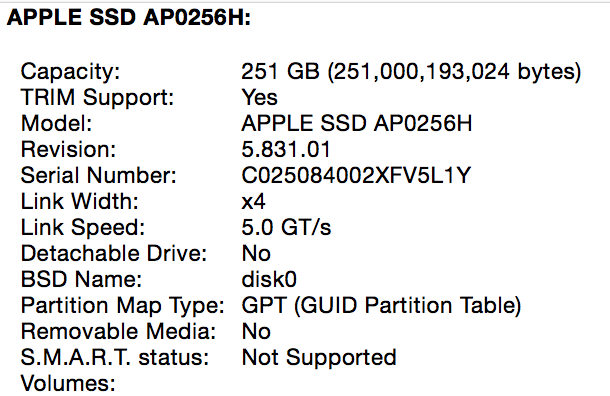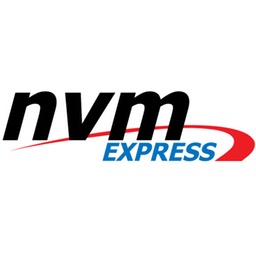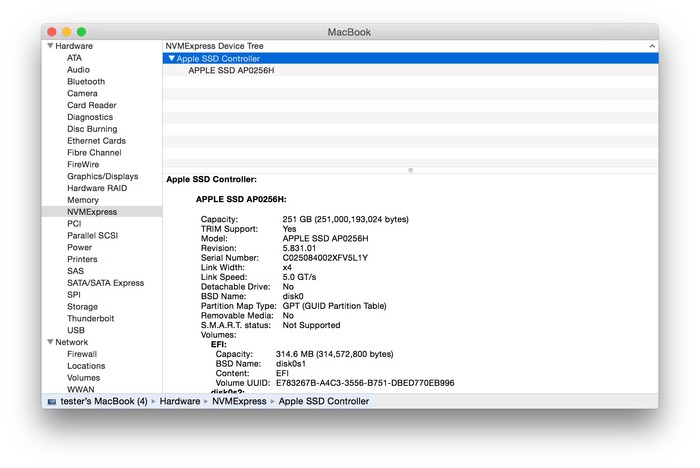MacBook (Early 2015)で新たに採用されたApple製コントローラーと新プロトコルNVMeに対応したSSDの記事が出てきたのでまとめました。
![]()
AnandtechやArs Technicaが新しいMacBook (Retina, 12-inch, Early 2015)の詳細レポートを公開しており、その中でNVMeとApple製の新しいSSDの性能が興味深かったのでまとめました。
The 2015 MacBook Review http://t.co/6Gte2PzMIL
The 2015 MacBook previews a future that’s not quite here http://t.co/ck1DGa95uo by @AndrewWrites
Apple製の新しいSSD
Anandtechのレビューによると新しいMacBookのSSDについては2つのポイントが有り「1つはOS X 10.10.3で新たにサポートされたAHCIに変わるPCIe SSDのためのプロトコル「NVM Express」とNVMe対応のSSDが採用されたこと、2つ目はSSDのモデル”AP0256H”となっており、今までと同じSamsungやToshibaなどではなくApple独自の”AP”というモデルナンバーがふられている」ということで、
So imagine my surprise when I opened up the System Profiler to see under the hood, and found not one but two unexpected things. First and foremost, a new section was available under the Hardware tree called NVMExpress. Second of all the device listed under NVMExpress has a model number prefix we’ve never seen before; not Samsung or Toshiba, but rather an Apple-ish “AP”. Clearly the MacBook’s SSD was going to be a much bigger deal than I first thought.
[The MacBook’s SSD: NVMe & an Apple Developed SSD Controller? – Anandtech]
このApple製のコントローラーはMarvellやSamsungのOEMだと予想されますが、このコントローラーはNVMe対応でリンク幅x4にも関わらず、リンク速度5.0 GT/s(PCIe 2.0の物理帯域)となっており、片方向辺り2GB/sのデータリンク帯域を持っているものの、

Shifting gears, let’s talk about the SSD controller. Along with supporting NVMe, Apple’s SSD also supports a fairly wide PCIe x4 connection. Somewhat surprising it’s only clocked at 5 GT/sec (PCIe 2.0 speeds), but it’s unclear at this time whether that’s a controller limitation or an intentional design decision by Apple. Even at 5 GT/sec, an x4 link means there’s 2GB/sec of bandwidth in each direction, which is far higher than how quickly the SSD can read or write.
[…]
At this point I’m not ready to rule out this being a better hidden OEM SSD, but the number of OEMs with NVMe capable client controllers is a very small list, so there aren’t too many options here. Of note, both Marvell and Samsung have NVMe capable client controllers, so this may yet be one of theirs’.
[The MacBook’s SSD: NVMe & an Apple Developed SSD Controller? – Anandtech]
ベンチマークスコアはあまり振るわず、ArsTechnicaのレビュワーのAndrewさんも一時は同じリンク幅を持っているMacBook Pro (Retina, Early 2015)とベンチマークスコアが違いすぎるため、レーン数を間違えて記載しており(現在は修正されています)
Like all other 2013, 2014, and 2015 MacBooks, the Retina MacBook’s SSD uses a PCI Express 2.0 interface rather than the older, slower SATA interface.
The difference in the 2015 MacBooks is how many PCIe lanes the SSD is connected to, which directly affects how much bandwidth is available to the drive. The 13-inch MacBook Air and Pro use four PCIe 2.0 lanes, while the 11-inch Air and the Retina MacBook use two lanes.Update: The MacBook’s controller does use four PCIe 2.0 lanes, though its peak performance still doesn’t match what you’ll get from a 13-inch Pro or Air.
[The 2015 MacBook previews a future that’s not quite here – Ars Technica]
これについてAnandtechのレビュワーSmithさんは「抄訳:(Appleから借りたレビュー用のMacBookは分解することを許可されていないから確認できないけど)Appleは新しいMacBookの限られたスペースにSSDを収めるため、NANDチャンネル数(NANDフラッシュメモリー数)を減らしているため、Readのスコアは他のMacBookと比較しても速いのにWriteはMacBook AIr Mid 2012より遅くなってしまっている」とコメントしています。
128KB sequential performance starts off very strong. The MacBook’s SSD is able to easily surpass any of our other Macs’ sequential read performance, delivering 665MB/sec under iometer. Meanwhile sequential write performance doesn’t quite top a 128GB SSD from a 2012 MBA 13, but otherwise it’s ahead of our other MBAs and rMBPs at 459MB/sec.
It’s actually a bit surprising that the SSD does this well here. Even with PCIe and NVMe, we’re looking at a highly integrated soldered solution, and I expect Apple has kept the number of NAND channels down in order to try to further conserve space. So to top our Mac charts in this fashion is unexpected and a bit impressive.
[The 2015 MacBook previews a future that’s not quite here – Ars Technica]
Smithさんが記事内でも述べているようにiFixitが詳細な分解レポートを公開してくれればNANDメモリの数もわかると思いますが、SSDのWrite値はNANDメモリ数によって左右される(いわゆるインターリーブ)ため新しいMacBookのSSD性能はRead/Writeでこのような差が出ているものと思われます。
おまけ
これもApple製のカスタムコントローラのためでしょうが、新しいMacBookではS.M.A.R.Tが非サポートになっているようで[1]、SMART Reporter や DriveDxなど一部アプリも使用できないものと思われます。

関連リンク:








コメント
最近のSSDはスピード勝負が旬らしいですが、
容量勝負、と言うか価格勝負の方が嬉しいですな。
MacbookProを持っていますが、どうしてもUSBのHDDが必要となる。
安価に4TBとかしてくれると、ノートパソコンの周辺が
スッキリするんですよね。
HDD完全無用の時代が来るのを御待ちしてます~
うわ、本当だ…SMART見れない…
512GBのモデルも書き込み遅いのかな
>>1
同意
NVMeはランダムRWのほうがよくきいてくるんだけど、MacではランダムRWまで計測するベンチマークソフトがあんまりないみたいだね。